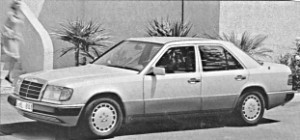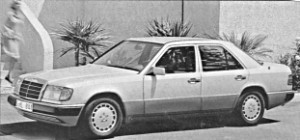
How to keep traction
 First introduced in Mercedes-Benz vehicles over 20 years ago, ABS makes it easier for the driver to control the car.
First introduced in Mercedes-Benz vehicles over 20 years ago, ABS makes it easier for the driver to control the car.
The ABS system, first introduced more than 20 years ago in Mercedes-Benz vehicles, is a set of devices that reduce the risk of blocking and, as a result, slipping of the car's wheels during heavy braking on wet or slippery surfaces. This feature makes it easier for the driver to maintain control of the vehicle.

Started with ABS
The system consists of an electronic control system, support wheel speed sensors and drives. During braking, the controller receives signals from 4 sensors that measure the speed of rotation of the wheels, and analyzes them. If the speed of one of the wheels is lower than that of the others (the wheel begins to slip), then this reduces the pressure of the fluid supplied to the brake cylinder, maintains the proper braking force and leads to the same thrust of all the wheels of the car.
The system has an extensive diagnostic function. After switching on the ignition, a special test is started to check the correct operation of the device. All electrical connections are checked while driving. A red light on the instrument panel indicates violations in the operation of the device - this is a warning signal for the driver.
System imperfection
During testing and operation, system shortcomings were identified. By design, ABS acts on the pressure in the brake lines and causes the wheels, while maintaining maximum grip between the tire and the ground, to roll on the surface and prevent clogging. However, on surfaces with different grip, for example, if the wheels of the left side of the vehicle roll on asphalt and the right side of the vehicle roll on the shoulder, due to the presence of different coefficients of friction between the tire and the road surface. ground, despite the properly functioning ABS system, a moment appears that changes the trajectory of the car. Therefore, devices that expand its functions are added to the brake control system in which the ABS is already working.
Efficient and accurate
An important role here is played by the electronic brake force distribution EBV, produced since 1994. It effectively and accurately replaces the operation of the widely used mechanical brake force corrector. Unlike the mechanical version, this is a smart device. If it is necessary to limit the braking force of individual wheels, data on driving conditions, different grip on the surface on the left and right sides of the car, cornering, skidding or throwing the car can be taken into account. Information also comes from sensors, which are the basis for the functioning of the ABS.
The scale of mass production has reduced the cost of production of the ABS system, which is increasingly included as standard on popular cars. In modern high-end cars, ABS is part of a safety package that includes stability and anti-skid systems.
» To the beginning of the article

